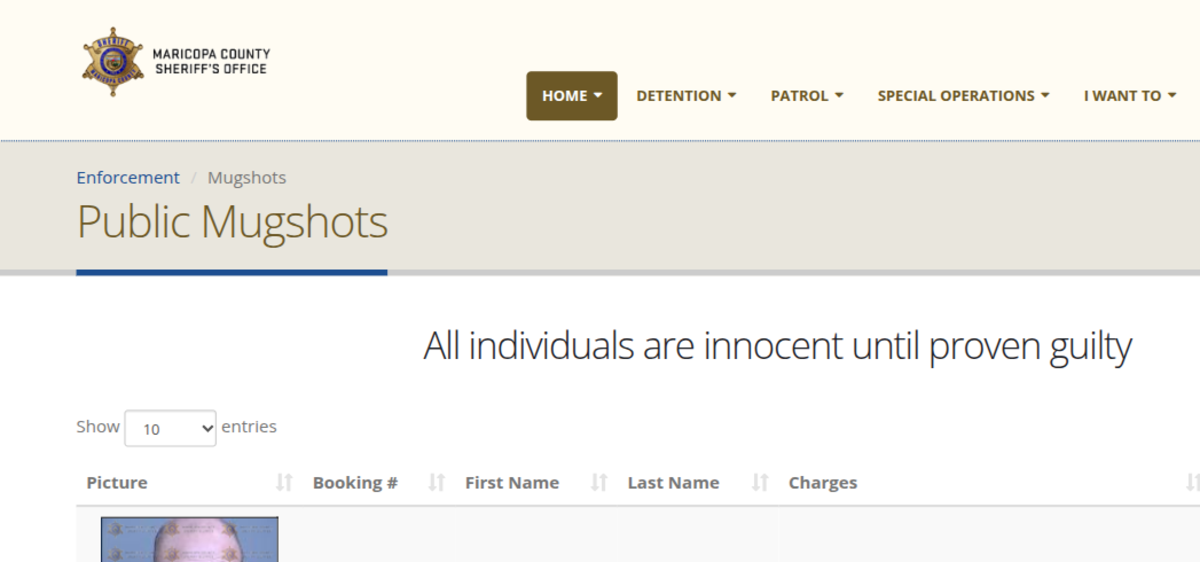
Josh Kelety

Audio By Carbonatix
Last September, a federal appeals court ruled that a mugshot lookup tool on the Maricopa County Sheriff’s Office website was unconstitutional and unfairly punished arrestees who had yet to face trial. In the wake of that ruling, the agency disabled the feature.
Less than a year later, with former Joe Arpaio acolyte Jerry Sheridan now serving as sheriff, the lookup tool is back. On Thursday, the sheriff’s office tweeted a link announcing the tool, which allows the public to see 100 recent mugshots, had returned. At the top of the webpage is written: “All individuals are innocent until proven guilty.”
There has been no change in the underlying court case, Houston v. Maricopa County. Andrew Ivchenko, one of the lawyers in that case, was surprised when Phoenix New Times told him that the sheriff’s office had restarted posting mugshots.
“I’m actually stunned that that’s the case,” Ivchenko said. “We just had a conference call with the legal team earlier. We’re pushing for this to be a class action lawsuit.”
Phoenix, make your New Year’s Resolution Count!
We’re $14,000 away from our End-of-Year campaign goal, with just a five days left! We’re ready to deliver — but we need the resources to do it right. If New Times matters to you, please contribute today to help us expand our current events coverage when it’s needed most.
Maricopa County resident Brian Houston sued the sheriff’s office, then led by Democrat Paul Penzone, in 2022. Houston’s mugshot had been posted on the agency’s lookup tool after he was arrested and charged with assault. Houston’s charges were dismissed, yet his mugshot and a host of identifying information appeared on the sheriff’s office website for three days.
Additionally, third-party sites routinely scraped the mugshots on the site and posted them elsewhere, causing reputational harm long after the images disappeared from the lookup tool. Houston’s lawsuit claimed “the notorious Mugshots.com website purports to publish the booking photos and arrest information of close to one million Arizona residents – the vast majority (834,000) from Maricopa County alone.”
Houston claimed the publication of his mugshot and personal information – including his birthdate, height, weight and eye color – constituted illegal pretrial punishment. A federal district court dismissed his claim, but a three-judge panel on the Ninth Circuit U.S. Court of Appeals reversed the district court’s ruling and agreed with Houston.
“Our question is whether Maricopa County’s policy of posting photographs of arrestees is constitutionally permissible,” Judge Marsha Berzon wrote in her opinion. “We conclude that it is not.”
In the wake of that decision, the sheriff’s office discontinued the mugshot lookup tool, though it continued to release booking photos in response to public records requests. But other jurisdictions in Arizona, including Pima County, stopped releasing booking photos altogether for arrestees who have not yet faced trial.

A screenshot of the revived mugshot lookup tool on the Maricopa County Sheriff’s Office website.
Maricopa County Sheriff’s Office
What changed?
At the time of the ruling, the sheriff’s office said it would consult legal counsel about the future of the lookup tool. Reached after the tool was reintroduced, sheriff’s office spokesperson William Jinks said the agency believes the new version of the tool passes constitutional muster.
“The changes made to the mugshot page are in accordance with the opinion of the appellate court,” Jinks.
Jinks did not answer a question about how the tool had changed specifically, nor did he say how long the mugshot page has been back on the office’s website. Bill Cracraft, a communication specialist for the Ninth Circuit, said the court had no comment.
The new version of the tool appears to contain a few adjustments in light of Berzon’s opinion. The site no longer lists an arrestee’s birthdate, height, weight, and hair and eye color. The listing for each now includes the arresting agency, which had been missing from the previous version of the tool.
Berzon’s opinion found that publishing much of the now-omitted personal information was unnecessary and served no legitimate transparency purpose for the sheriff’s office. She also took the agency to task for omitting relevant information like “the names of the officers who arrested Houston, the location of his arrest, the arresting agency, the jail in which Houston was held, and whether charges were ultimately pursued.”
The new lookup tool still leaves out much of that information, aside from the arresting agency.
Berzon also wrote that the previous mugshot lookup tool enabled photo-scrapers to collect the photos and publish them online, where they “remain available after they are removed from the County website, even if the arrestee is never prosecuted, let alone convicted. The result is public exposure and humiliation of pretrial detainees, who are presumed innocent and may not be punished before an adjudication of guilt.”
It’s unclear what steps the new site takes to prevent photo-scraping. Photos on the lookup tool are watermarked with the sheriff’s office logo and do not appear to be clickable for copy-and-paste purposes, though they can be dragged into a separate document. Additionally, nothing would seem to prevent a person or a bot from screenshotting the photos.
Ivchenko told New Times that his team was reviewing the new webpage and forming an opinion on it. Jared Keenan, the legal director of the ACLU of Arizona, had no comment on the new site. However, after Berzon issued her opinion in September, Keenan expressed his concerns about the mugshot database to Arizona’s Family.
Officers “only need probable cause to make an arrest, that’s a very small amount of evidence,” he told the station, which results in lots of people being arrested “who later have their charges dismissed because there is not enough evidence they actually committed a crime.” Despite that, the mugshot tool created a stigma that could follow them long after their booking photo disappeared from the sheriff’s office site.